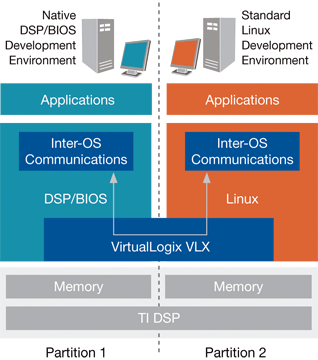Telecom DSPs gain Linux virtualization
Oct 31, 2007 — by Eric Brown — from the LinuxDevices Archive — 7 viewsCellular base stations can now harness digital signal processors (DSPs) for general-purpose control-plane functions as well as signal processing, according to VirtualLogix. The company has ported its VLX-NI virtualization layer and Linux kernel for network infrastructure equipment to Texas Instruments DSPs used in base stations and other networking data-plane applications.
Previously, VLX-NI supported only Intel Architecture processors, and thus targeted deployment on the control plane. However, VirtualLogix has long supported TI DSPs, though a VLX-DM (digital multimedia) product aimed at low-cost set-top boxes.
The TI DSP-flavored VLX-NI can reportedly run Linux and TI's DSP/BIOS (a “rich set of deterministic kernel services”) simultaneously on single- or multi-core DSP processors in TI's C64x+ line. According to VirtualLogix, this provides the flexibility to more cost-effectively develop network services such as 3G and WiMAX base stations, as well as media servers and gateways.
VirtualLogix VLX NI for DSPs supports normal DSP/BIOS and Linux dev tools
(Click to enlarge)
VirtualLogix's VLX products include a microkernel that acts as a virtualization layer, dividing the hardware's physical resources among different OS instances. When used on processors like DSPs that lack built-in virtualization hardware, the OS instances require light modifications. Thus, VirtualLogix bundles a modified Linux kernel with its new VLX-NI DSP offering. However, the offering supports normal development tools for both TI's DSP/BIOS environment and for Linux.
In cellular base stations, DSPs are typically used only for signal processing applications like modem control and voice transcoding (i.e., down-sampling in challenging RF conditions). Previous versions of VLX-NI were optimized for Intel Xeon multiprocessors, and used primarily to let operators preserve legacy software investments, which typically ran on Solaris or an in-house OS, while using Linux for new software development efforts.
Now, VirtualLogix says, system designers can leverage a DSP platform to handle traditional control-plane tasks. The company claims that this unified platform isolates proprietary DSP/BIOS applications and drivers from open-source Linux, while enabling local control in parallel to data processing.
According to VirtualLogix, the new product reduces the cost of upgrading to new 3G, WiMAX, or Long Term Evolution (LTE) technology. In addition to consolidating hardware, carriers can use the platform to expand their selection of available software, says the company, as well as speed implementations through remote monitoring and debugging during field trials.
Stated Mark Milligan, VP of marketing at VirtualLogix, “TI multicore DSPs are ideal for 'Beyond 3G' base station and next generation media gateways. Now VLX provides the capability to integrate required signal processing applications with advanced platform management, control, and debug solutions — all without adding another board or processor.”
Availability
The TI-DSP version of VLX-NI is available now for the following TI C64x+ DSP versions: TMS320C6455, TMS320TCI6482, and TMS320TCI6487/88. Pricing was not disclosed.
This article was originally published on LinuxDevices.com and has been donated to the open source community by QuinStreet Inc. Please visit LinuxToday.com for up-to-date news and articles about Linux and open source.
